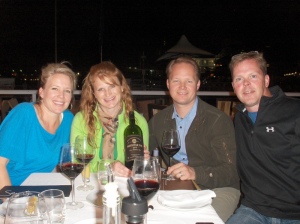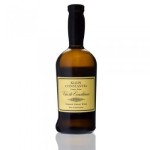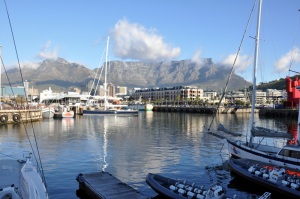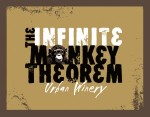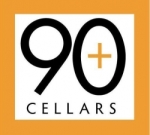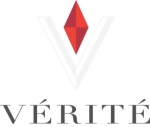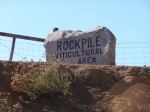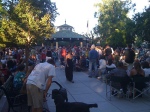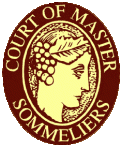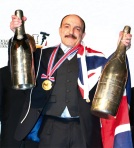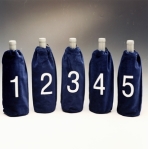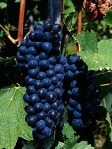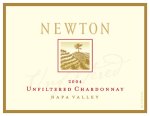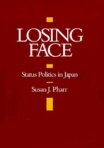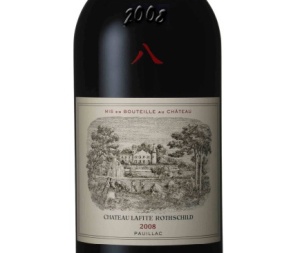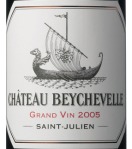 “Today, God be Praised, wine was pressed at the Cape for the first time”
“Today, God be Praised, wine was pressed at the Cape for the first time”
– Jan van Riebeeck, February 2, 1659
“Constantia…has healing powers on a disappointed heart”
– Jane Austin, in Sense and Sensibility
When was the last time you overheard someone talk about, “…that excellent South African wine they had last weekend?” If the answer is “seldom”, or “never”, then you are in good company, because most Americans don’t know much about South African wines. The question then, that follows is, “What reason is there to learn anything about a world wine region that has difficult to access wines, which most people really don’t know much about?” The answer is that not only is there plenty of reason to get to know more about South African wines, but there is a lot of misinformation about this diverse compilation of African wine growing regions, and moreover the wines really aren’t as inaccessible as you might think. In addition, there are really compelling reasons to make the wines of South Africa your go to wines for any occasion. I recently returned from a trip to South Africa and am here to say that these wines deserve your attention. The southern Cape Wine districts are among the most bio-diverse in the world, and the microclimates created by the competing influences from the Atlantic and Indian oceans make for unique growing conditions that balance against the hot African summer sun which tend to ripen the grapes in New World fashion.

The Logo for the Dutch East India Trading Company
South African wine production can trace its history back to 1659 and the Dutch East India Trading Company when the company established a Spice Route supply station at the Cape of Good Hope in the South-Western part of Africa for their ships as they passed around the African Cape on their way to and from India and Asia. A Dutch surgeon, Jan van Riebeeck was given the task of running the supply outpost, and in addition to planting the fruit crops to prevent scurvy for the sailors, van Riebeeck planted the first vineyards in Southern Africa. In 1685, then current Cape governor, Simon van der Stel (whom the town of Stellenbosch was named after), founded the first true wine producing estate–Constantia, which later became the world renowned producer of Constantia dessert wine (now resurrected as Vin de Constance). The South African wine industry flourished in the 1800s under British rule, until the 1860s when France forced tariffs (specifically the Cobden-Chevwith tariff) with England that favored wines from France over South Africa.
In the late nineteenth century the wine lands of South Africa were devastated by the Phylloxera epidemic, and it was none other than Cecil John Rhodes, the founder of De Beers Diamond and Consolidated Gold Fields Mining Company, and Prime Minister of South Africa who brought Phylloxera resistant, American rootstocks to South Africa and saved the wine industry. The trouble was that South Africa was replanted and over-production ensued. The quality of the wine was bland, neutral bulk wine, and lots of it. In 1918, the Koöperatieve Wijnbouwers Vereniging van Zuid-Afrika Bpkt (KWV) was founded by the wine farmers in the region. The KWV controlled the business of wine farming and distribution until the end of Apartheid in the early 1990s. The trouble was that the policy of producing higher volume, lower quality wine was perpetuated. It was under the KWV that the Wine of Origin (WO) program was started. The WO is loosely based on the AOC system in France, and its primary function is concerned with accuracy in labeling with respect to geographical regions. The underlying purpose of the WO, however, was to raise the quality of the wine produced and exported. This scheme is important in its role of protecting both the wine producer and consumer. Production in South Africa over the years has proved that each area of origin lends its own unique character to wine and that certain areas deliver better quality for specific varietal types. Currently in South Africa, single vineyard designated “Estate” wines don’t classify as a designation of geographic origins, but South African wineries can still label wines as “Estate” wines provided that all the grapes were grown and the wine vinified and bottled on the same property.
The nine South African wine farm geographic regions encompass a wide range of area, ranging from the North and West Cape, but I am going to concentrate on the Southern Cape wine districts of Constantia, Stellenbosch, Paarl and Franschoek. The historic Constantia estate has briefly been previously mentioned, and the Constantia district encompasses five distinct estates: Groot Constantia, Steenberg, Buitenverwachting, Klein Constantia, and Constantia Uitsig.
Constantia is south of Capetown on the Cape Peninsula which juts out into the Atlantic Ocean. Because of its location, the region receives significant oceanic influences which create a cooling effect that causes a long slow summer ripening period. The soils are a combination of sandstone, loam and granite which give a fair amount of drainage for the vines.
Paarl is the home of the KWV, and the valley is dominated by the Paarl Mountain. The region’s fertile soil and Mediterranean climate (hot Italian, and most New World weather as opposed to the cooler Northern French, Spanish and German climates) has been used for farming by French Huguenots for orchards, vegetables, and of course vineyards since the 17thcentury. Two of my favorite wine farms located here are Fairview and Glenn Carlou (which is one of the six New World wineries owned by the Hess Estate).
The famous Stellenbosch wine district is surrounded by the Drakenstein, Papegaaiberg, Simonsberg and Stellenbosch mountains, and has a temperate Mediterranean climate which is moderated by oceanic influences of the nearby False Bay. The soils found there range from hillside decomposed granite to sandy alluvial loam near the Erste River. The town of Stellenbosch has a unique European feel with its wide avenues and cafes and Cape Dutch architecture. Stellenbosch is home to many world class wineries including Jordan (known as Jardin in the USA), Meerlust, Rust en Vrede, Simonsig and Warwick, Waterford Estate.
Franschoek was founded by French Huguenot settlers. The region includes higher elevation vineyards which contribute to slightly cooler summers that can generate higher acidity in their many notable white wines produced there. The region boasts many fantastic restaurants and bed and breakfasts and celebrates its French heritage with many local festivals. One of the most beautiful wine estates, in terms of its Cape Dutch architecture is Boschendal Estate, at one time owned by Cecil J. Rhodes.
South African wine farms grow grapes from practically all the internationally known cultivars. All of the five noble grape varietals, in addition to Shiraz, and Zinfandel, Chardonnay and Viognier are grown there. But when I think about South African wines, I think of Pinotage and Chenin Blanc. Pinotage was first bred in South Africa in 1925 as a cross between Pinot Noir and Cinsaut at Stellenbosch University. Cinsaut was known at the time in South Africa as Hermitage, hence the name Pinotage. Pinotage proved to be an easy varietal to cultivate, but it was largely ignored by the rest of the world because of its green vegetal flavors, and susceptibility for developing banana and nail polish-acetone flavors. Isoamyl acetate sometimes develops during the vinification process which can lead to a pungency that smells like paint. However, over the past ten years Pinotage has been reexamined as a serious varietal, and has had proper winemaking techniques applied to it, and with proper oak cooperage. Any Pinotage made after 2003 will confuse one’s palate with its desirable characteristics and depth of flavor. To my palate, they taste more like Rhone wines with an interesting earthiness. In addition, it has been proven that the Pinotage varietal contains the highest concentration of antioxidants out of all wine varietals. Kevin Zraly, in his Windows on the World Wine Course has some specific thoughts on Pinotage that I happen to agree with. He states that the best producers of Pinotage, “… have vines that are older than fifteen years and are planted in cooler climates, are green harvested so that the per acre yield is very low; have long skin maceration in open fermentation; is blended with Cabernet Sauvignon (although I have had delicious Pinotage blended with Shiraz); and is aged for at least ten years.” The Pinotage in this category can be aged more than twenty years, with tremendous fruit extraction and very harmonious balance that does everything one would hope a top quality wine would be.
Chenin Blanc (or Steen, as it was known in South Africa until the 1960s) is the most widely planted varietal in the entire country of South Africa. It probably either came with the French Huguenots who initially settled in the Franschoek valley or in cuttings sent to Jan van Riebeck by the Dutch East India Company. The Chenin Blanc varietal provides a fairly neutral substrate for uniquely expressing the terroir in which it is grown and the winemaking techniques by which it is vinified. Chenin Blanc yields large crops in the fertile South African soil, and green harvest techniques are frequently employed to remove excess grape clusters. Chenin Blanc can accommodate some skin contact and maceration which will allow extraction of phenolic compounds that add to the complexity of the wine. Additionally, South African winemakers tend to ferment Chenin Blanc at a lower temperature (52-54 degrees F) than their French counterpart in order to maximize the tropical fruit flavors and aromas that naturally and more vividly come out with cooler fermentation temperatures.
On my trip to South Africa, I tasted wines from many Estates, and as it turns out, many of the world class wines actually do have North American importers, it is simply the wine stores who don’t request the wines because there is such a paucity of demand for these unknown gems. John Hartley, of Happy Holiday tours (www.happyholiday.co.za) took us to Fairview Estate in Paarl for a wine and cheese master tasting.
Fairview is known for their incredible Shiraz collection, beginning with the Beacon Shiraz, and progressing through the Eenzaamheid Shiraz, and culminating in their top first press Cyril Back Shiraz (The 2007 Cyril Back was a Decanter magazine Gold medalist in the World Wine Awards). All of the Fairview Shiraz wines display a dense garnet color with intense current and minerality and spice, but not too peppery.
The Waterford Estate in Stellenbosch (no relation to Waterford Irish Crystal) has a beautiful wine cellaring / aging room. We had a wonderful wine and chocolate pairing experience there. Waterford produces many excellent wines, but their flagship is “The Jem”, which is a meritage, heavy on Cabernet Sauvignon, but takes a turn away from Bordeaux by adding Shiraz, Mouvedre, Sangiovese and Barbera. The result is an intensely structured wine that has balance and complexity and a New World mouthfeel.
Another wine highlight was a magnum of the 1997 Meerlust Rubicon that we had at Sevruga Restaurant at the Victoria and Alfred Waterfront in Capetown. This wine was another Bordeaux blend with excellent structure, integrated tannins, cassis, and hints of cedar wood. The Meerlust Estate in Stellenbosch has been family owned for eight generations, since 1756. The beautiful winery incidentally was declared a National Heritage Monument in 1987.
South Africa has always been known for the quality of its white wines, and one not to miss is Steenberg Magna Carta 2009 from the Constantia district. A blend of 60% Sauvignon Blanc and 40% Semillon, it was a top scoring wine in the Decanter Magazine’s Expert Choice list. The wine displays a multilayered expression of the vineyard’s terroir, and as South Africa’s Platter’s Guide describes, “… it exquisitely balances an oaky richness, sauv’s raciness and sem’s honey-lemon character.” This brilliant offering is truly a benchmark wine for Steenberg.
One of the most interesting, and celebrated, wines to come from South Africa is Constantia. In 1778, the owner of Constantia Estate, Hendrick Cloete, produced a wine made from a blend of Muscat de Frontigan, Pontac, Muscadel and Chenin Blanc. This wine became a favorite of European kings, such as Frederick the Great, George IV, Louis Philippe, and Napoleon. It also made it into popular culture, being written about in such classic works as Jane Austen’s Sense and Sensibility, and Charles Dickens’s The Mystery of Edwin Drood. When Phylloxera laid waste to the South African vineyards, Constantia disappeared for almost one hundred years. It was resurrected in 1980 by Klein Constantia in a dutifully recreated, and delicious, Muscat based version called Vin de Constance. The 2007 version is arguably the best since its resurrection. It is copper in color, and exotic in fragrance with notes of citrus, honeysuckle and clove. It has a strong acid thread with a slight oak backbone, and a fabulously long finish. This wine will age for a generation. Vin de Constance is widely available in the US and I highly recommend picking some up.
It is not so easy to travel to South Africa with the purpose of taking in the wine farms of the area. But the wines have a long history that bring forth a little bit of Europe’s complex foray onto the African continent. The specter of Apartheid and subsequent US sanctions against South Africa hid these wines from American consumers for so long, that it is easy to see why they are not on most American wine drinker’s minds. On his deathbed in exile on the island of St. Helena, Napoleon did not ask for Chambertin, or Chateau d’Yquem, he asked for Constantia. Now I can truly see why. Because of the uniqueness of the geography from which they come, the vineyard sustainability practices, and the skill by which the wines are vinified, the wines can compete with any world wine region on their own merits. Couple that with the fact that the US dollar is currently strong against the South African Rand and these very affordable wines are flying under the radar in China and Europe all means that this is a great time to get to know South African wine. That’s all for now.
Cheers,
Karl











